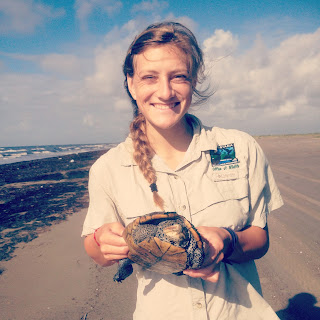This week was definitely an eye-opener week for me. One reason I wanted to take this class was so that I could narrow down what I want to focus on in the field of marine biology. This week helped me to figure out some things that I definitely don’t want to do in this field.
First thing, I will not be doing offshore work. Ever. On Wednesday, we got the opportunity to participate in studies done on an offshore research vessel. Knowing that I get motion sick, I showed up prepared. I had my motion sick wristbands, I had taken non-drowsy Dramamine, I used motion ease, and I had lots of ginger snacks. I still got sick. I was sick from about 11am to about 7pm. The only thing I could do to help the motion sickness was to sit at the front of the boat and watch the horizon, or sleep. So, aftter a much-needed 2 hour nap, I actually felt pretty good. I was pretty upset that I wasn’t able to participate in the first site data collection because I was sick, but I was really excited to be in on the action at the second site. I really loved the data collection process. We collected specimens using a dredge and an otter trawl. Once we collected the samples, we categorized them into buckets and used field guides to identify their species. Then we would count and measure them and record all data found. It was a really cool experience and it was cool being able to identify species that we had never seen before. It required lots of teamwork and coordination, and I really enjoyed it. I’m glad it was only a 12 hour trip though because I don’t know how much longer I could have stayed on the boat for. Overall, it was a really cool experience being able to participate in a study on a research vessel.
I also learned two other things that I will not be doing in my marine biology career. I will not work with sponges and I will not work with plankton. The sponge was literally the most awful thing I’ve ever smelled in my life. It was absolutely terrible, and it never went away. It was just really hard to focus and dissect it when all I could think of was my nose hairs pretty much melting from the awful smell. Sponges are super cool and I love learning about them and I could see myself studying them but only if they’re still in the water and I don’t have to smell them. Also, plankton was a topic of this week that was really cool and interesting, but I don’t see myself pursuing a career with plankton. One of our tasks was to get a petri dish of one of the plankton samples we collected on the boat. The plankton sample we had in my group was so overwhelming. When putting the petri dish under the microscope, we couldn’t even see the bottom of it because it was just covered in plankton. It was just layers on top of layers of plankton. We had never even seen or studied plankton very much, and we were supposed to identify them and count them. It was just extremely overwhelming and we didn’t even know where to start or how to handle it. With one of the plankton species we identified, we determined there to be 97,761 total in the sample after all the calculations. It was just a really difficult task for us and we didn’t really enjoy it very much. The good thing about this class though is that it is helping us to narrow down our choices of where to go next in this field. There were some things that I did enjoy this week, but it more helped me to see what I don’t want to do in marine biology. I look forward to what I will learn in these next few weeks.
































